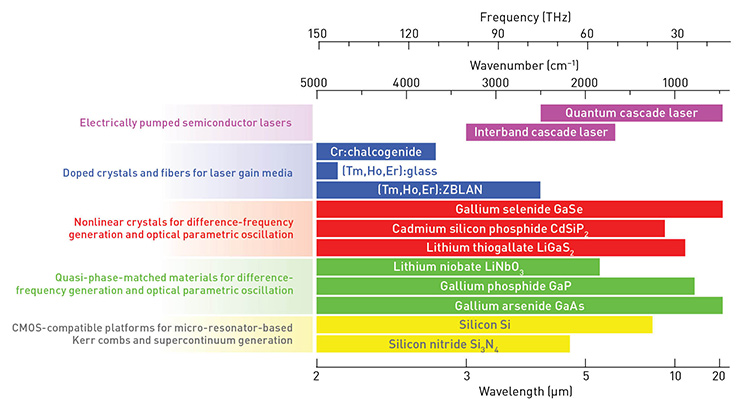1. 4 ~ 3 μm laser crystals doped with Er2+, U4+, Ho3+, Dy3+
As an active ion, Ho3+ has achieved laser output in the ~3 μm band (5I6→5I7). In 1976, researchers first realized 2.9 μm laser output in Ho:YAP crystal. In 1990, Bowman et al. obtained 2.85 μm and 2.92 μm laser outputs in Ho:YAP crystals, and obtained 2.92 μm band-tuned laser outputs in Ho:YAP crystals in the following year. In 2017, Nie et al. pumped Ho, Pr: LiLuF4 crystals with a 1 150 nm Raman fiber laser, achieving 2.95 μm watt-level laser output for the first time. In 2018, Zhang et al. obtained a laser output with an average power of 257 mW and a slope efficiency of 0.04% in Cr, Yb, Ho, Pr:GYSGG crystals. In the same year, Nie et al. achieved the highest laser output power of 1.27 W in Ho, Pr: YLiF4 crystal, and the slope efficiency reached 28.3%. In 2004, Jackson et al. achieved a laser output of 2.5 W in Ho, Pr:ZBLAN glass fiber (fluoride containing ZrF4, BaF2, LaF3, AlF3 and NaF components), with a slope efficiency of 29%. In 2014, Crawford et al. achieved a laser output of 3.4 W and a slope efficiency of 20.9% in a Ho:ZBLAN glass fiber pumped by a Raman fiber laser.
Exciting effects of Dy3+ as active ions in low phonon energy fluoride optical glass fibers (ZBLAN) are achieved. In 2003, Jackson achieved a laser output with a maximum output power of 275 mW and a slope efficiency of 4.5% in Dy: ZBLAN. In 2016, Majewsky reported a laser output of 810 mW in 3.04 μm band and a slope efficiency of 51% by using Dy: ZBLAN. In 2018, Woodward et al. used Er:ZBLAN 2.83 μm laser resonant pumping to realize the laser output of Dy:ZBLAN fiber in 3.15 μm band with output power 1 060 mW and slope efficiency up to 73%. Unfortunately, the laser output in 3 μm band of Dy3+ ion-doped laser crystals has not been realized so far.
The main development trends in the future: (1) At present, the rare earth activated ions that can achieve 2.8-3.3 μm mid-infrared laser output at room temperature mainly include Er3+, Ho3+ and Dy3+, among which Er3+ is the most studied. But in general condition, most of the laser transition formed by the Er3+ activated ions are line-like and short-wavelength. But the mode-locking output of the fs laser in Er3+ is worth looking forward to. (2) In comparison, the number of electrons in the 4f shell of Ho3+ and Dy3+ is even, and the Stark energy level splitting in different crystal fields is different, which is relatively greatly affected by the crystal field. Therefore, the fluorescence spectrum produced by the laser crystals doped with Ho3+ and Dy3+ in the range of 2.8-3.3 μm is a smooth broadband spectrum. This gives tuned (ultrafast) laser output, and connects and expands the Er3+ waveband to the infrared direction. The development of laser crystals (classified by active ions and wavelengths), from Nd3+ and Yb3+ with wavelength of 1 μm, Tm3+ and Ho3+ with wavelength of 2 μm, to Er3+ with wavelength of 2.6-2.8 μm, and then to Ho3+ with wavelength of 2.8-3.3 μm and Dy3+, etc., continue to develop in the direction of mid-infrared, which is the forefront of laser crystal development. It is very possible for Ho3+ and Dy3+ to achieve high-efficiency laser output in the range of 2.8-3.3 μm. Glass fiber Ho: ZBLAN has given 21% slope efficiency laser output, glass fiber Dy:ZBLAN has given resonant pumping slope efficiency as high as 73% laser output. But ZBLAN fluoride glass fiber has many shortage including deliquesce, having aging color center, being fragile and difficult to polish and weld, and the glass fiber has low doping concentration, strong nonlinear effect, and low energy-bearing ability. Therefore high-energy applications are still dominated by solid-state lasers. However, there are few studies on Ho3+-doped crystals in the ~3 μm band, and the slope efficiency is still too low to have practical application. So far there is no report on laser output of Dy3+-doped crystals in ~3 μm band, which limits its application in high-energy directional infrared confrontation, biomedicine, environmental monitoring, etc. However, it is worth looking forward to the ~3 μm band laser output obtained by the Dy3+ doped laser crystal. (3) Considering that the oscillator strength of the energy level transition of Actinide ions is generally 1 to 2 orders of magnitude larger than that of Lanthanide ions, U4+ doping is a kind of laser crystal with development potential and worthy of attention in the mid-infrared band.
Post time: May-30-2023

